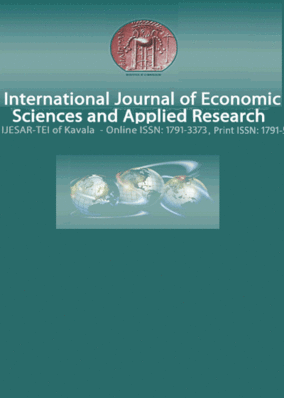Structural breaks, parameter stability and energy demand modeling in Nigeria
Part of : International journal of economic sciences and applied research ; Vol.5, No.2, 2012, pages 129-144
Issue:
Pages:
129-144
Abstract:
This paper extends previous studies in modeling and estimating energy demand functions for both gasoline and kerosene petroleum products for Nigeria from 1977 to 2008. In contrast to earlier studies on Nigeria and other developing countries, this study specifically tests for the possibility of structural breaks/regime shifts and parameter instability in the energy demand functions using more recent and robust techniques. In addition, the study considers an alternative model specification which primarily captures the price-income interaction effects on both gasoline and kerosene demand functions. While the conventional residual-based cointegration tests employed fail to identify any meaningful long run relationship in both functions, the Gregory- Hansen structural break cointegration approach confirms the cointegration relationships despite the breakpoints. Both functions are also found to be stable under the period studied. The elasticity estimates also follow the a priori expectation being inelastic both in the long- and short run for the two functions.
Subject (LC):
Keywords:
energy demand modeling, structural breaks, parameter stability, cointegration
Notes:
Περιέχει πίνακες και βιβλιογραφία
References (1):
- Akinboade. O., Ziramba, E. and Kümo, W., 2008, ‘The demand for gasoline in SouthAfrica: An empirical analysis using co-integration techniques’. Energy Economics, 30,6, pp. 3222-3229Alves C. and Rodrigo, 2003, ‘Short-run, long-run and cross elasticities of gasoline demandin Brazil’, Energy Economics, 25, 2, pp. 191-199.Andrews, D., 1993, ‘Tests for parameter instability and structural change with unknownchange point’, Econometrica, 61, pp. 821-56.Andrews, D. and Ploberger, W., 1994, Optimal tests when a nuisance parameter is presentonly under the alternative ’, Econometrica. 62, pp. 1383-1414.Banerjee, A., Lumsdaine, R. and Stock, J., 1992, ‘Recursive and sequential tests of theunit-root and trend-break hypotheses: Theory and international evidence’, Journal ofBusiness and Economic Statistics, 10, 3, pp. 271-287.Baochen, Y. and Shiying, Z., 2002, ‘Study on cointegration with structural changes’,Journal of Systems Engineering. 17, 1, pp. 26-31.Bentzen, J. and Engsted, T., 2001, ‘Revival of the autoregressive distributed lag model inestimating energy demand relationships’, Energy, 26, 1, pp. 45-55.Central Bank of Nigeria, Central Bank of Nigeria Statistical Bulletin. 2008.Chakravorty, U., Fesharaki, F. and Zhou, S., 2000, ‘Domestic demand for petroleum inOPEC countries’, OPEC Review, 24, 1, pp. 23-53.Cheung, K. and Elspeth, T., 2004, ‘The demand for gasoline in china: a co-integrationanalysis’, Journal of Applied Statistics, 31, 5, pp. 533-544.Dahl, C. and Kurtubi, 2001, ‘Estimating oil product demand in Indonesia using acointegrating error correction’, OPEC Review, 25, 1, pp. 1-25.Dahl, C., 1994, ‘A survey of energy demand elasticities for the developing world’, TheJournal of Energy and Development, 17, 1, pp. 1-47.Dahl, C., 2006, ‘Survey of econometric energy demand elasticities ’, Colorado School ofMines, Golden, ColoradDayo, F. and Adegbulugbe, A., 1987, Oil demand elasticities in Nigeria’, Energy Journal,8,2, pp. 31-41.De Vita, G., Endresen, K. and Hunt, L., 2006, ‘An empirical analysis of energy demand inNamibia ’, Energy Policy, 34, 18, pp. 3447-3463.Dickey, D., Fuller, W., 1979, ‘Distribution of the estimators for autoregressive time serieswith a unit root’, Journal of the American Statistical Association, 74, pp. 427-431.Eltony, M., 2003, ‘Transportation demand for energy: the case of Kuwait’, The Journal ofEnergy and Development, 28, 2, pp. 207-220.Eltony, M., 2004, ‘A model for forecasting and planning: the case for energy demand inKuwait’, The Journal of Energy and Development, 30, 1, pp. 91-108.Engle, R. and Granger, C., 1987, ‘Cointegration and error correction: representation,stimation, testing’, Econometrica, 55, pp. 251-276.Granger, C. and Newbold, 1974, ‘Spurious regressions in econometrics’, Journal ofEconometrics, pp. 111-120.Gregory, A. and Hansen, B., 1996, ‘Residual-based tests for cointegration in models withregime shifts \ Journal of Econometrics, 70, pp. 99-126Gregory, A., Nason, J. and Watt, D., 1996, ‘Testing for structural breaks in cointegratedrelationship ’, Journal of Econometrics, 71, pp. 321-341.Halicioglu, F., 2007, ‘The demand for new housing in Turkey: an application of ARDLmodel’, Global Business and Economics Review, 9, 1, pp. 62-74.Halicioglu, F., 2007, ‘Residential electricity demand dynamics in Turkey’, EnergyEconomics, 29, 2, pp. 199-210.Hansen, B., 1992, ‘Tests for parameter instability in regressions with 1(1) processes’,Journal of Business and Economics Statistics, 10, pp. 321-335Hendry, D. and Juselius, K., 2000, ‘Explaining co-integration analysis: Part F, EnergyJournal, 21, 3, pp. 1-42.Hendry, D. and Juselius, K., 2001, ‘Explaining co-integration Analysis: Part II’, EnergyJournal, 22, 1, pp. 75-120.Hughes, J., Knittel, C. and Daniel S., 2006, ‘Short-run gasoline demand elasticity: evidenceofstructural change in the U.S. market for gasoline’, Working Paper, Institute ofTransportation Studies University of California, Davis.Iwayemi. A., Adenikinju, A. and Babatunde, A., 2010, ‘Estimating petroleum productsdemand elasticities in Nigeria: A multivariate cointegration approach’, EnergyEconomics, 32, pp. 73-85Johansen, S., 1991, ‘Estimating and hypothesis testing of cointegration vectors in Gaussianvector autoregressive models’, Econometrica, 59, 6, pp. 1551-1580.Leyboume, S. and Newbold, R, 2003, ‘Spurious rejections by cointegration tests inducedby structural breaks\ Applied Economics, 35, pp. 1117-1121.MacKinnon, J., Haug, A. and Michelis, L., 1999, ‘Numerical distribution functions oflikelihood ratio tests for cointegration’, Journal of Applied Econometrics, 14, 563-577.Perron, P. and Vogelsang, T., 1992, ‘Nonstationarity and level shifts with an application topurchasing power parity’, Journal of Business and Economic Statistics, 10, 3, pp. 301 -320.Pesaran, M., Hashem, M., Smith, R. and Akiyama, T., 1998, ‘Energy demand in Asiandeveloping countries’, Oxford University Press for the World Bank and Oxford InstituteforEnergy Studies.Philips, R, 1986, ‘Understanding spurious regression in econometrics ’, Journal ofEconometrics, 33, pp. 311-340.Phillips, P. and Ouliaris, S., 1990, ‘Asymptotic properties of residual-based test forcointegration’, Econometrica, 58, pp. 165-193.Phillips, P. and Perron, R, 1988, ‘Testing for a unit root in time series regression’, Biometrika,75, pp. 335-346.Polemis, L., 2006, ‘Empirical assessment of the determinants of road energy demand inGreece’ , Energy Economics, 28, 3, pp. 385-403.Stock, J. and Watson, M., 2003, ‘Introduction to Econometrics’, Pearson Education,Boston, MA.Zivot, E. and Andrews, D., 1992, ‘Further evidence on the great crash, the oil-price shock,and the unit-root hypothesis’, Journal of Business and Economic Statistics, 10, 3, pp.251-270.




